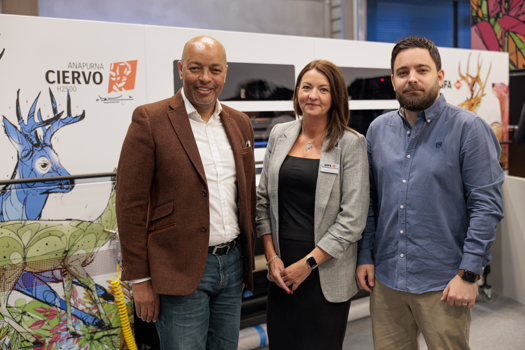When talking about security print, it is useful - probably the first time in history he has been useful - to paraphrase former US secretary of defence Donald Rumsfeld. His famous quote made at the height of the War on Terror, and subsequently much derided in the press, actually makes some sense when tweaked slightly and applied to the blossoming security printing industry: there are things you know about security print; there are things you know you don't know; and there are things you don't know that you don't know.
What you know is that the market is flourishing. Traditional security clients such as banks and governments have been joined by high-value brands and ticketing companies wishing to give their products some extra protection. What you know you do not know is the costs that would have to be incurred to reach this high margin and expanding sector. And then the thing you don’t know you don’t know: security printers say the sector is more complex and varied than you might imagine. The question for commercial printers eyeing security printing is whether the risk of the latter is worth the benefits of the former.
That the security market is expanding, presenting opportunities to printers eyeing high margins, is a ‘known known’ for most. Print remains a fundamental part of security procedures – able to work in environments where digital cannot, such as areas with no internet or 3G, and where the high cost of infrastructure to support digital security features cannot be met. Also, packaging and pharmaceutical companies are increasingly looking to capitalise on the affordability of print security to protect their brands and their
consumers.
"There are now more organisations, governments, companies and individuals than ever wanting to protect something they own or control and security print is how they can do that effectively, reliably and affordably," reveals Vlad Sljapic, sales director for digital printing solutions at Domino Printing Sciences.
Good news
The good news for commercial or packaging printers, according to print industry manufacturers, is that this burgeoning market is becoming more accessible than ever.
"Digital machines are improving, so new opportunities are developing for those that have high-quality digital capabilities," explains Koen Heyndrickx, business manager for security printing at Agfa, which offers the Fortuna anti-counterfeit software. "Print is catching up with the capabilities of the software we are putting out and that is letting more printers get into the security areas."
HP UK sales team leader Ralph Bates agrees: "The scope is there for customers and we can really do very sophisticated things now, such as micro-text and QR codes and variable data and imagery. It is just a question of printers taking up that option. There are a lot of issues with security and counterfeiting for brands and they are really searching out a cost- effective solution to remedy them."
Apex Digital Graphics sales and marketing director Neil Handforth adds that this is not just a digital capability. At Drupa, Ryobi showed how the UV casting and foiling capabilities of its 1050 and 750 series could produce security features such as holograms and special effects such as foiling and chemical embossed printing. This development was in response to demand from packaging print clients for affordable security print features, says Handforth.
Heyndrickx is keen to point out, however, that this kit will not necessarily be a free ticket into security print. He says the sector is split into levels of sophistication and that your kit will restrict how far up the security chain you can go.
"The limitations of the security design features are dictated by the output device. If you are printing at 300dpi, then you have one limit, but If you are printing at 600dpi, you are at a different limit," he explains.
Security printer Smith & Ouzman director Nick Smith expands on this and explains that as you go higher, it is not just the quality of the output devices that matters, but also the range of output devices. He explains that for security applications, you need layers of security and that this will require a number of different print processes.
"You need many outputs to produce features, as one document could use the whole spectrum – litho, letterpress, screen, foils and holograms, digital print," he explains. "The lower-level protection is probably more accessible, but if it is something anyone can do, you’re not really in the security print market, as you’re not really giving any protection. For most security applications, you will need multiple outputs."
Bates and Handforth would argue that for the level of security their kit seeks to achieve, users do not need this multiple output capability as the presses do a number of different layers in one machine. Bates admits, though, that software investment would have to be made to go alongside the HP kit for variable work.
"In terms of cost and printing speed, many of the security features do not change from printing a conventional job. It makes no real difference to the machine itself," he reveals. "The real cost comes in the pre-press, in setting up the designs and the RIP for any variable data."
Be it in software or kit, though, most printers would class the need to spend money to get into the sector as a ‘known known’. Yet those in the industry already say that the costs don’t end with hardware or software. Tall Group managing director Martin Ruda says the administration side can be just as costly.
"Printing organisations choosing to operate in the secure print environment are finding that the administrative and regulatory demands being placed upon them are becoming more complex and, therefore, more expensive to support," he explains. "To maintain all these requirements is a never-ending effort and expense."
The accreditations and which regulatory requirements you have to meet changes depending on the sector you are in. For cheque printing, for example, you need more systems and accreditations in place than to print some secure packaging, but less than if you want to print money.
Of Communisis’ cheque printing facilities, the company’s managing director of transactional services Tony Strong says: "All our sites are governed by the cheque printer accreditations scheme, and all our factories are subject to controls and management protocols and that incorporates the ISO security standard as well. We also have strict staff and client vetting protocols. So there is a lot of procedure in place that needs to be complied with."
Again, though, as with the kit investment, this level of spend on the admin side will not surprise many – most would class it as an ‘unknown known’, in that they would expect to have costs for regulations, they just did not know how much exactly.
So far: nothing too scary. Unfortunately, however, Smith & Ouzman’s Smith says there are plenty of things printers may not be expecting, ‘unknown unknowns’, too. For starters, he says that security printing is now not just about print.
"The biggest change we have seen in the last five years is that we are now combining the traditional security print features with electronic features such as internet verification or microchips," he explains.
Sljapic from Domino, which supplies print solutions to hundreds of security printers globally, agrees. "It is the link between the electronic and the print that is giving us the heightened security," he explains. "It is the print that gives you a unique code that you SMS to see if it is genuine; it is the printed micro QR code that can be scanned and connected electronically to a database so the user knows it is authentic and the brand knows it has been sold in the right region."
Smith says catering for this newly merged security world has meant his IT department has tripled in size and that it can now develop electronic security features such as client web portals where clients can track and control their jobs, and secure SMS or email broadcasts. "It really is a multiplatform world and the customer wants it generally from a single source," he explains.
Maximum security
Which brings us to what is probably the other ‘unknown unknown’: customer service. Those buying security print are as under pressure financially as any other sector and so getting the maximum security for the minimum amount is still the priority. Also, Smith says that the client nearly always expects the printer to suggest the solutions and source the security elements. As a result, Smith says printers in this sector need the security industry knowledge and the time to handhold a client to get the work.
"The majority of clients will rely on us to provide the expertise as to what they need and what is available. They will expect us to source all the elements – both print and digital – for a job," he says. "There are so many variables, so every job is bespoke. There is obviously some trust that we are recommending the right features and not the most expensive features – our experience means we can give the service clients want."
The latter could, in the end, prove the biggest barrier. The cost of regulations and accreditations, as well as new kit and IT services, may be extensive, but on the promise of higher margins, this could be justified. The really difficult issue would be having the experience and knowledge in-house to take the client’s hand and lead them through the security market. That experience could be brought in, of course, but trust is such a major part of the security industry that the time to establish a reputation that would win work could be too long for some. As Sljapic says: "At some level you can still get into the market, but the problem is winning the work."










